Problems can equal opportunities, but only in hindsight
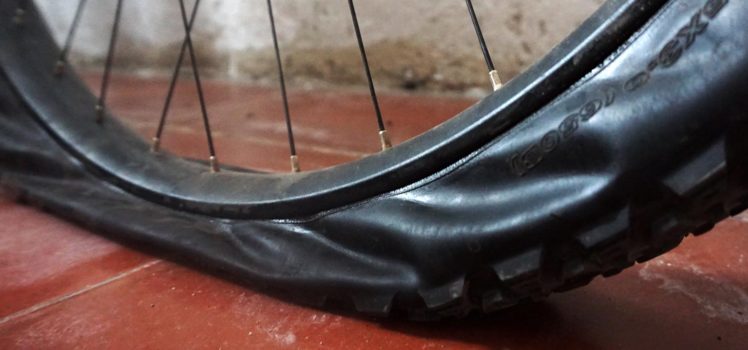
I guess I should have known better than to write a post publicly stating that we’ve had no bike problems. Bikes, like boats, obviously don’t appreciate that kind of attention. Although problems, aka challenges, may be stressful when they’re occurring, doesn’t it seem, when you look back on them, that they often result in some of the more positive experiences? It appears that way to me, but only in hindsight. Problems definitely suck when they’re occurring!
Our time in Mulegé was relaxing. We stayed in a little inexpensive guest house, and took the time to do some exploring on our unloaded bikes. We also had the opportunity to connect with a couple of other cyclists who we learned were, some time ago, a few weeks behind us. Tommy and Tyler started off riding in Colorado, and intend to ride to Patagonia, as we do. We spent a fun afternoon together where lunch turned into drinks and then into a second lunch. Cyclists can eat a lot!
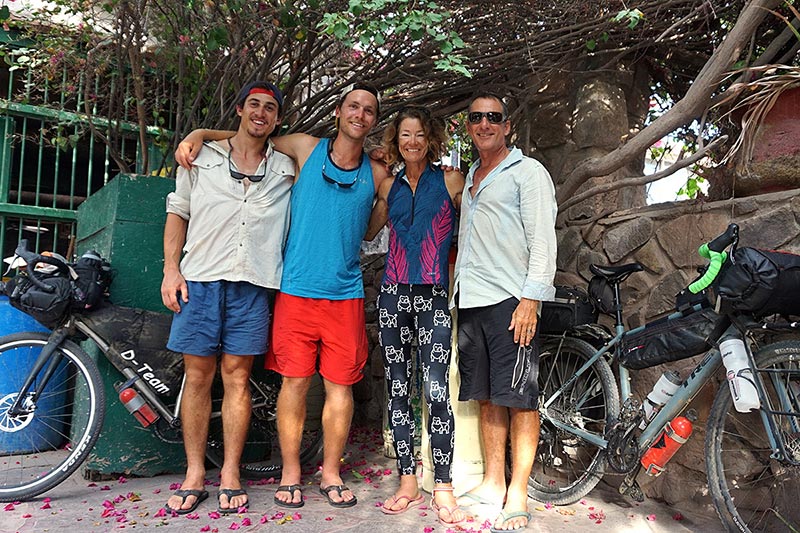
Tommy and Tyler after our dual-lunch afternoon.
Tommy and Tyler have a unique way of sharing their tour. They are producing an audio podcast entitled The Spoken Tour. Check it out!
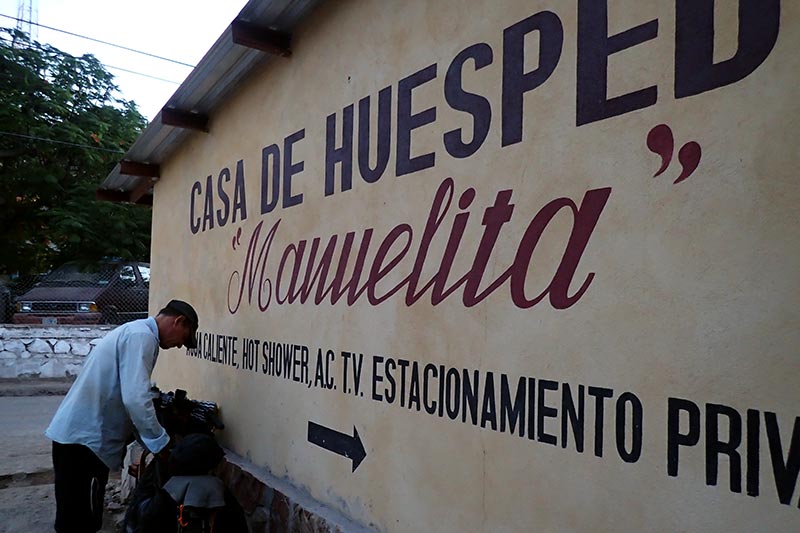
Departing our Mulegé home.

We got a jump on the day, and were at the fishermen’s beach at sunrise.

Negotiating for our ride.
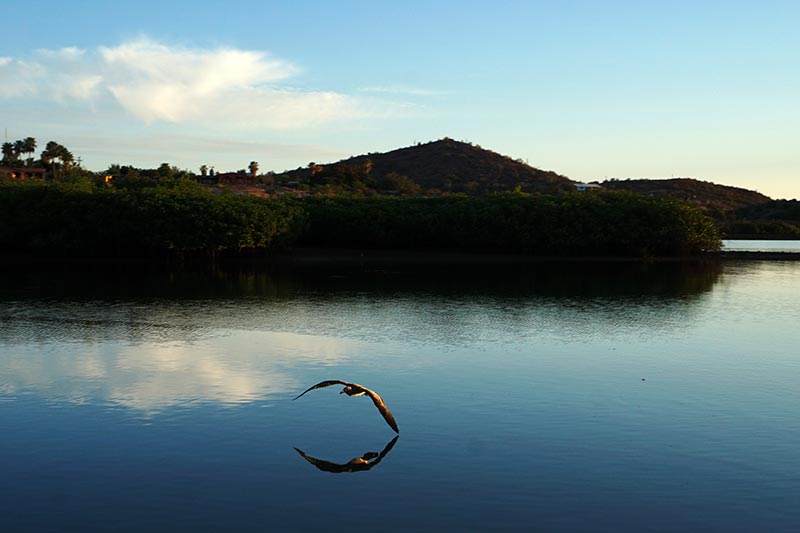
Killing time before we leave the dock.
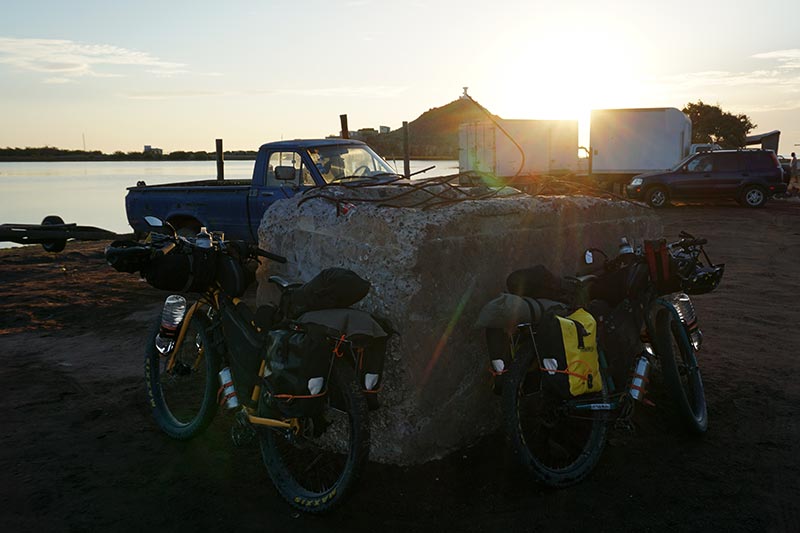
Our steeds are ready for the trip.

Mulegé truly was a great place to visit.
When it came time to leave Mulegé, we rode from our guest house just as it became light enough to see, making our way to the fishermen’s beach. It didn’t take long to organize passage for us and our bikes to Los Hornitos. After only a 30-minute wait, our boat Captain, Fausto, zipped us across the Bahia de Concepcion, where he left us to continue on our way.
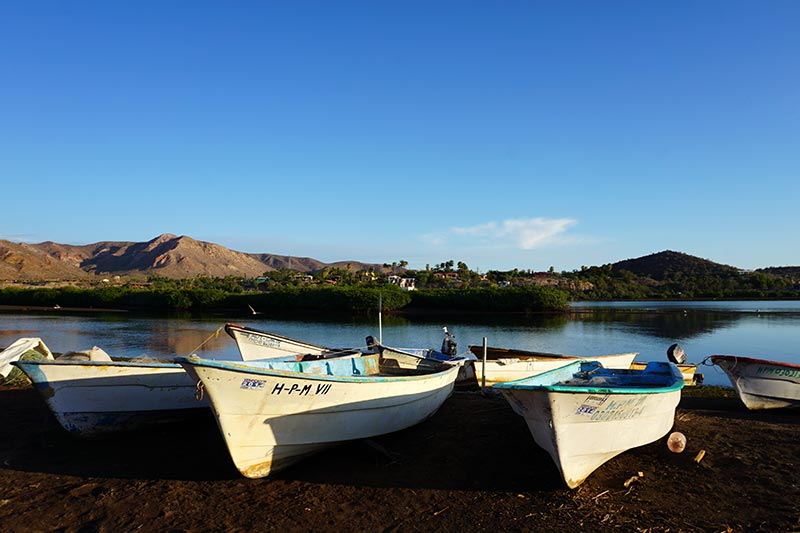
Multiple pangas ready to go to work.

A photo of the photographer.

Loading the bikes into the panga.

We’re on our way, Captain Fausto at the helm.

Approaching Los Hornitos.
TIP: It is best to tell the Captain that you wish to go to the sandy beach just south of Los Hornitos. That is actually where the trail really begins, and will save you a bit of time and effort making your way there from the rocky point. Plus it’ll be a much nicer landing for you and the boat. Note that we did not know this!

Bikes are repacked and ready to go.

Looking back towards Mulegé.
Following a short swim, we set off from the beach on what we expected to be a very sandy trail. As recommended in the route description, we lowered the pressure in our tires before doing so. Not only was this probably not necessary, it would also prove to be the source of what has become a course-altering problem. Within a mile or so of departing the beach, after negotiating a quick down and up gully, I popped the bead on my rear tire.

Ready for a swim?
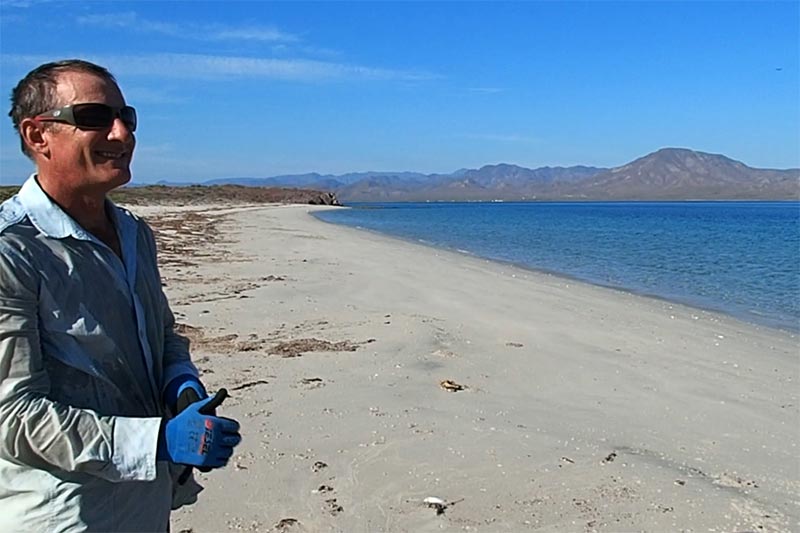
Definitely! Look how much I am sweating, and it’s only 9:00 AM!
For those not familiar with tubeless setups, and a year ago, I wasn’t, the bead of the tire mates to the rim in such a way that it can hold air, and no inner tube is required. The tires have some liquid sealant inside them which helps the seal to stay intact, and also to stop the flow of air should any small thorns be picked up (larger ones can be repaired with special plugs). Running a tubeless setup does allow you to run lower than normal pressures, a good thing for sandy areas, but when too low, you run the risk of breaking the seal. This is obviously what I had done. No problem, we’ll just fix it, right? Easier said than done.

Well, that didn’t go as planned!

Taking advantage of what little shade there is.
Just as people were often surprised to hear that I lived on a boat but could barely swim, it probably seems funny that I’m touring on a bicycle but had never patched a flat tire. It’s true. Well, there’s a first time for everything.
Getting a tubeless tire to seal can apparently be a bit tricky, and it’s difficult to do with a hand pump. We were carrying a couple of small CO2 cartridges to be used in such a situation, but having never done this job before, we blew through both of those without success. Following those failures, I attempted some battlefield repair tactics. I won’t go into any great detail because they were not successful, but I will admit that they involved some crazy glue and duct tape.
Unable to get the tire to reseal, we really had only one choice: revert to the traditional method and insert a tube. Even though we each carry one tube for just such an occasion, I was extremely reluctant to do this as I knew that we’d be giving up the benefits of our tubeless setup. Unfortunately, we really had no choice. My fears of getting a flat tire were obviously warranted because within an hour, my tire was no longer full of air. It’s worth pointing out that the section of trail we were riding had more tire-deflating thorns than we have seen since the 10-mile stretch from the beach to Rosarito!
Patching a flat is no doubt easy for experienced cyclists. We are not experienced cyclists! It was only when I removed the tube that I realized my serious mistake: I forgot to check the tire for thorns before I inserted the new tube. When running tubeless with sealant, the tire can pick up multiple thorns but still hold air, and that is exactly what it had done. My brand new tube had not one puncture, but at least four (that we could locate). We sat on the shadeless trail for well over an hour, sweating buckets, attempting to patch the punctures. The rim, tube and metal tools got so hot that we could barely touch them. We had some success but our job was not perfect. We also almost completely exhausted the one and only patch kit we were carrying (we had plenty of plugs to fix holes in the tubeless setup, but a very limited amount to fix the last-resort inner tube).

Our campsite has a boat, of course.

And plenty of shells. Never did figure out what this was all about.

First attempt at starlight photography.
It was at this point that we had a decision to make: do we continue on, riding a trail that had at least 30 more miles before we could replenish our water supply, with limited patches, or do we ride back to the deserted fishing camps that we passed earlier and hopefully find some fisherman who could give us a ride back to the mainland. Yes, this was probably the worst place for this to happen! Ironically, we were on one of the more remote stretches of the trail and yet still had cell service. If only we had a friend with a boat to call!
It goes against both of our natures to turn back, and so we carried on, putting in a very low-milage first day. We did find a nice beachside camping spot late in the afternoon, and actually spent most of the night sleeping under the stars before the bugs drove us into the protection of our tent.
Happily, the next day started off better. The tire was, for the most part, holding air, and we put in some decent miles on trails that were much less littered with thorns. Unfortunately, having spent more time stationary the day before than we had planned to, we were a bit under the gun to get to a spot where we could obtain some more water. When we reached San Sebastian, an area where apparently a bunch of ex-pats live, we found no one home in any of the beachside residences. We were, however, invited into the home of one of the nearby Mexican residents and he was quick to top up our water bottles.

Morning ride with the Bahia de Concepcion to starboard.

The best light of the day.
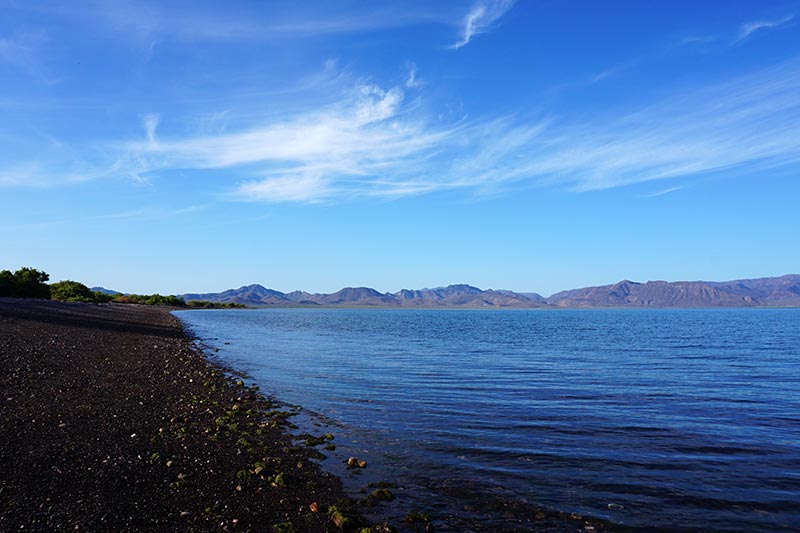
Breakfast and coffee break!

This stretch of riding was nice and flat, and pretty much thorn free.

Shade at 10:30 AM. By noon there will be none.

Still nice and flat, and fast.
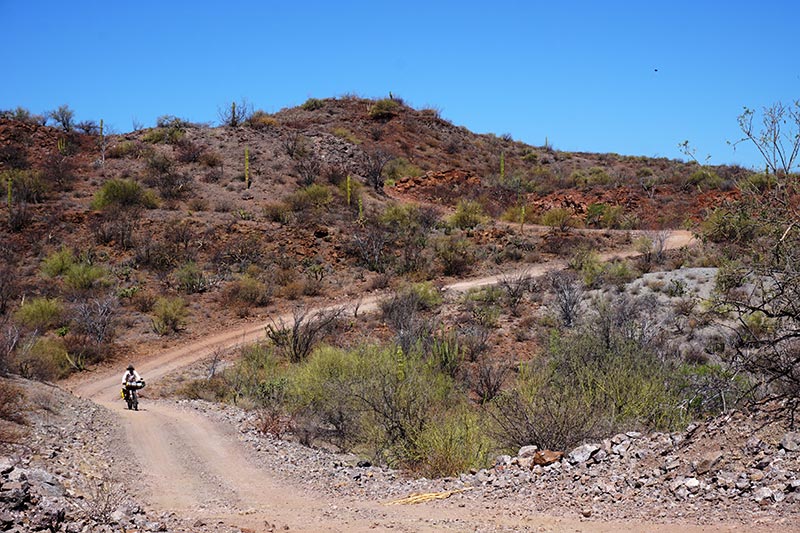
Now, not so flat!
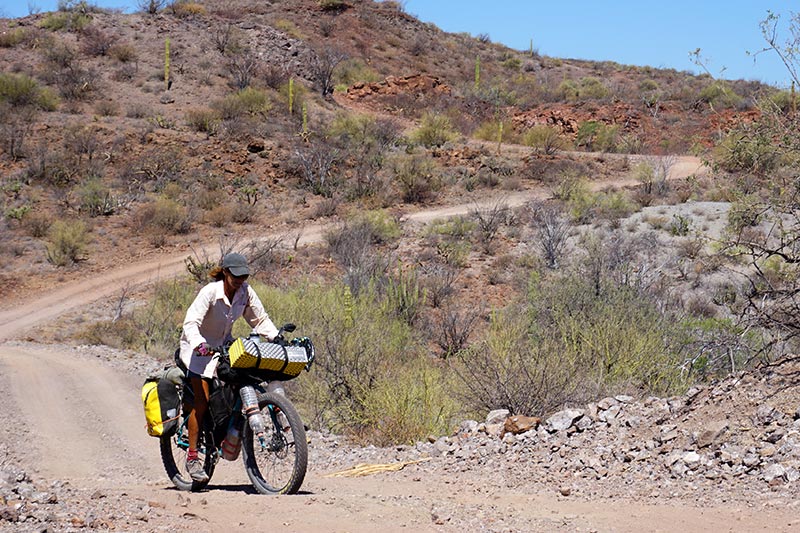
Standing up out of the saddle.
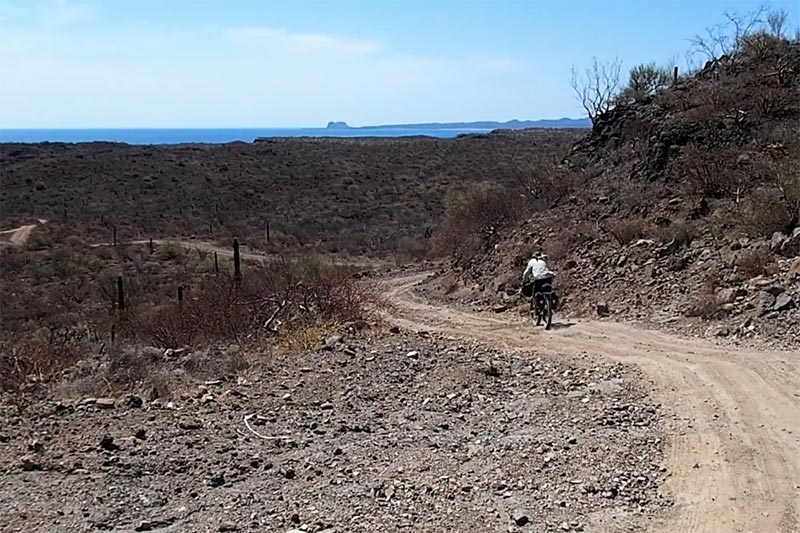
Down and up, up and down.

Rest break. Note translucent shirt. It was hot and sweaty!

The coastline should be flat, right?
When we reached San Nicholas, a tiny community a couple of miles off the route, we guzzled down several cartons of cold juice from the one and only store. Referring to it as a store is actually stretching things a bit as the shelves were nearly bare. They did have cold juice though, and purified water, so we were satisfied.
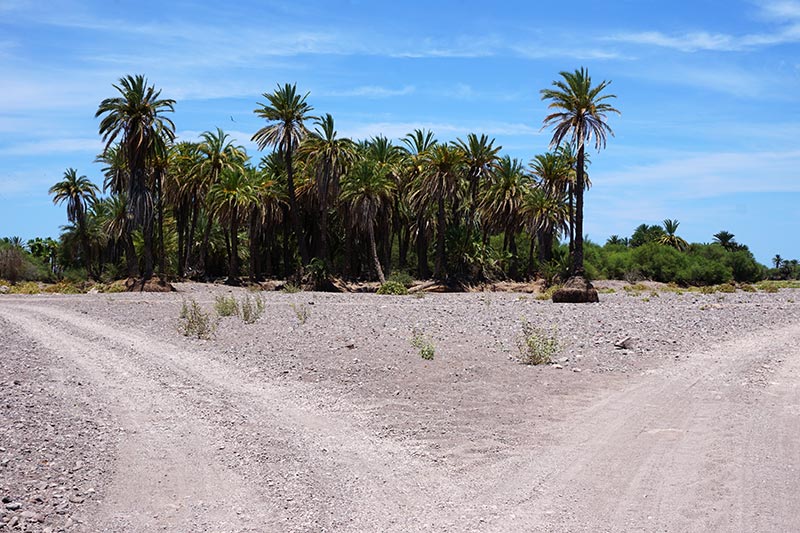
Our map didn’t specifically say where San Nicholas was, and we had some issues finding it.
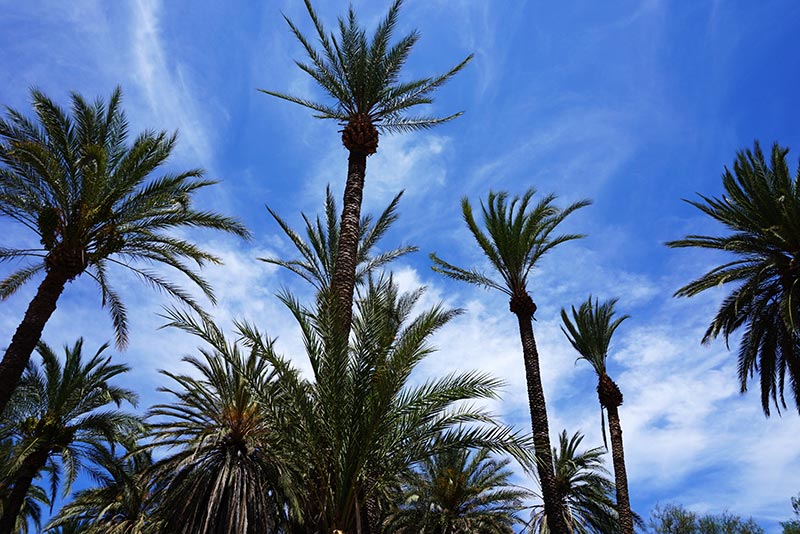
When you want to take pics but are too tired to leave your shady hiding spot.

I typically make fun of shots like this but the cow staring at me made it worth it.
It was then a little after 3 in the afternoon, and rather than continue on to El Rosarito, a truck stop on the highway some 10-12 miles away, we decided to head down to the beach to see if we could find a place to camp. This would turn out to be one of the best decisions we have made.

The horses are smart, hanging out in the water. The donkeys and cows were doing the same.
Once by the water, we pulled up beside a palapa with 4 guys inside chatting. I went over to say Hi and to ask if it was OK to camp around there. After explaining where we had come from and where we were going, something that was difficult for them to comprehend until I explained that we were traveling off road, they invited us to stay in an under-construction palapa just in back of where they were. We quickly took them up on their offer, and after getting ourselves cleaned up, we joined them for what would turn out to be a great night.
Luis Alejandro, his son of the same name, and Juan Pablo, were extremely generous hosts. We were soon to learn that they could all speak very good English, but in spite of that, we continued to try to muddle our way through conversations in Spanish. They fed us fresh ceviche, and Mexican-style beef, and served us glass after glass of whiskey and coconut water. The party likely would have continued on even later than it did if we had not politely declined the offer of “one more” and made our way to bed, knowing that we had a big day of riding ahead of us.
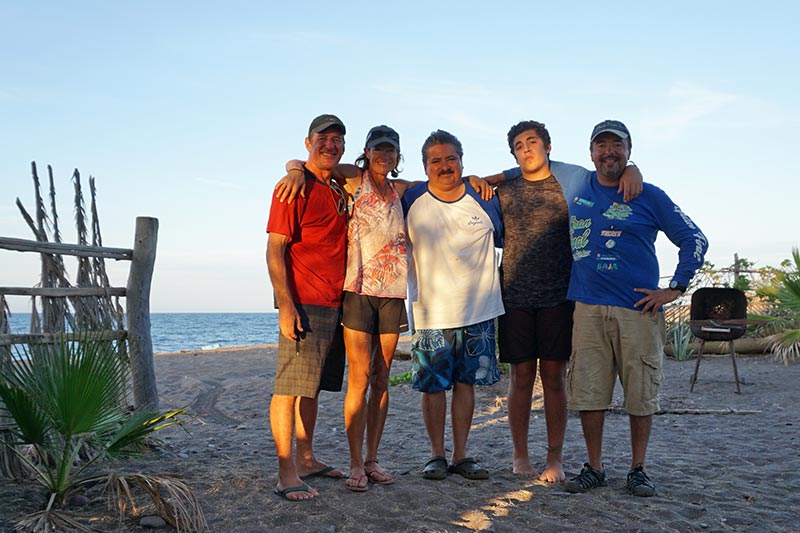
Our gracious hosts!
When we awoke the following day, we had another decision to make. Do we continue on with the Baja Divide route, or divert to Loreto to try to fix the bike? We had planned to make a couple more attempts at restoring the tubeless setup, using a small compressor that the guys had, and also an aerosol can of Slime tire sealant, used to re-inflate car tires, that Juan Pablo gave to us. Unfortunately, none of the things we tried would work. It seemed to us that we must have damaged the tire when we first dislodged it, a problem that was preventing all of our repair attempts from working. Yes, we could still put the tube in, and we did, but riding trails that are oftentimes full of thorns is not something that we were comfortable with, and especially so because there was about 160 miles until the next big city and we had only a couple of patches remaining.

The day is getting started.

We tried, but had no success in reseating the tire.
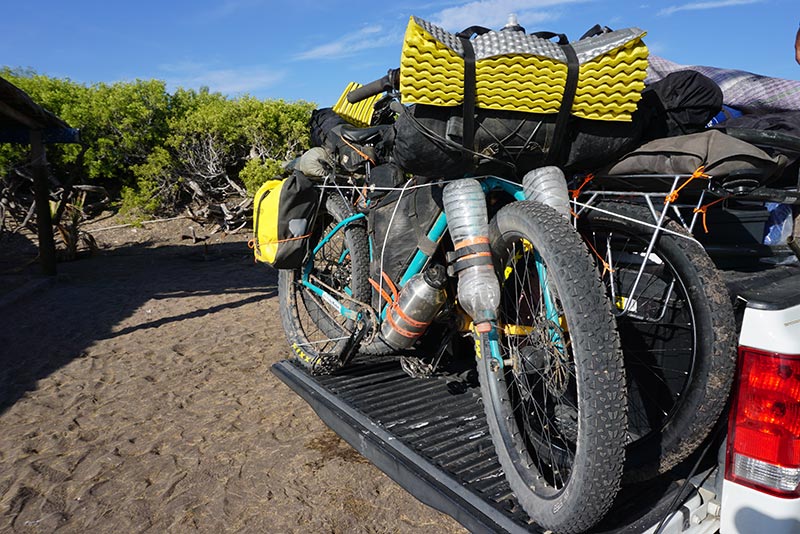
Ready to head to the highway.
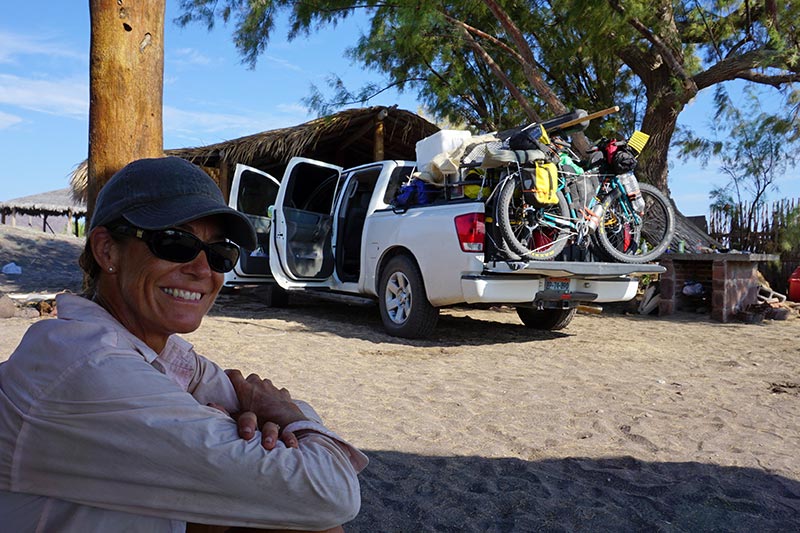
Our bikes will be safe, right?
The smart call was to divert to Loreto, a city that numerous people had told us was beautiful, and a must-visit spot. At their insistence, we loaded the bikes onto the back of the guys’ truck, and they drove us the 11-mile stretch to El Rosarito and the MEX1 highway. Their vacation over, the guys were heading back home to Tijuana, and so they turned north at the highway. We, on the other hand, pointed our bikes south.
Highway riding is like Caribbean sailing, it’s always into the wind!
It was just shy of 40 miles from that point to Loreto, on a highway with no shoulder, and far more traffic than I really appreciated. To compound our problems, my tire still had a slow leak, one that, at the beginning, would allow the air to stay in for about an hour, but by the end of the day, required pumping up every 5-20 minutes. Yes, we could have hitch-hiked, but we prefer to help ourselves when possible. Yes, we could have put in Rebecca’s spare inner tube, but I really wanted to leave that as a last resort. So, coupled with more swearing than I know Rebecca appreciates, I just kept on riding, and pumping up the tire when needed.

More flat patching practice on the way to Loreto.

While the above repair was ongoing, these dust storms were spinning just behind us.
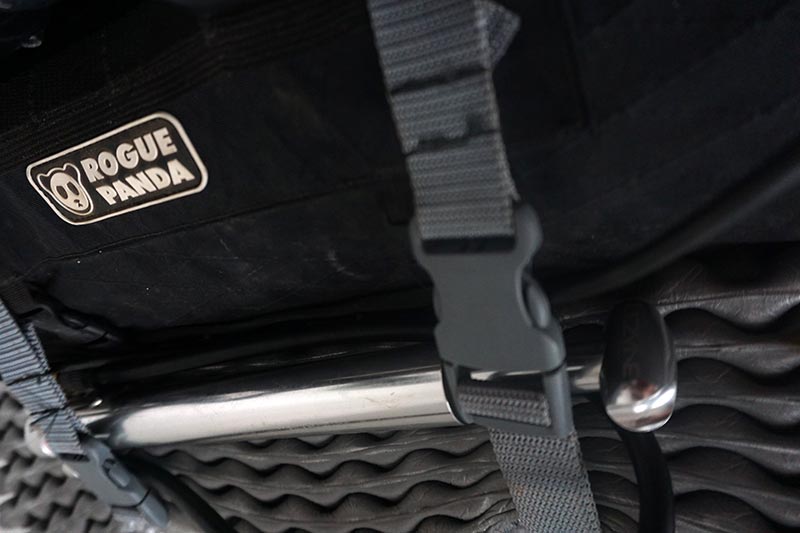
You know things are bad when you have to keep the air pump handy.
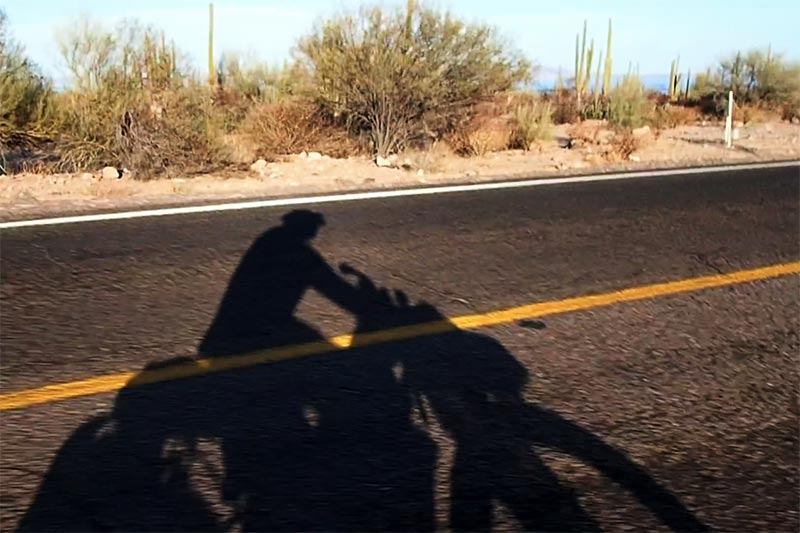
Almost there.
When we ultimately reached Loreto, a town of some considerable size, we took advantage of a tip that our new friends shared with us. They explained that most every Mexican town is built with the same pattern. In the center of the town is a park, and around that park will be some government buildings, a church, and an inexpensive hotel. We zoomed in our iPhone app to find the park, and sure enough, within a block of where it was located, we found a posada, a small hotel.
While rehydrating with a couple of 2-for-1 margaritas, I sent our friend Salvador from FASS Bikes a message and explained our predicament. He let me know that he had some tires in stock, and also that he knew the owner of the bike shop here in Loreto. A repair plan, some margaritas, and later, an excellent pizza, are just about all I need to make me forget the problems of the past couple of days. Like I said, had those issues not occurred, we would never have met our new friends, nor made our way to this cool Baja town.

A shower, a change of clothes, margaritas and pizza, the cure for all.
- UPDATE: Earlier today, Salvador sent us four new tires (they are all getting worn down), an inner tube to replace the one that I killed, some sealant to set up the new tires, and some other miscellaneous parts. We’ll have them by tomorrow, and with Manny’s help from the local bike shop, we’ll be back in business!
Trip Stats:
- Mulegé to Wild Camping: 44.4 km (includes a 13km boat ride), 12:17 hours
- Wild Camping to San Nicholas: 45.5 km, 8:44 hours
- San Nicholas to El Rosarito: Approx. 18 km drive in truck
- El Rosarito to Loreto: 62.7 km, 6:49 hours


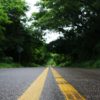

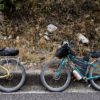

I’m glad you got to stop in Loreto. The islands off Loreto (Isla Carmen) are some of our favorite cruising grounds.
I can see how this area would be excellent to cruise in.
Wow. What a gruelling experience. I can’t imagine having to stop and pump up the tire that often in that heat. Again – I don’t know how you do it. Something I always seem to be saying to you guys.
I love it that the issues had a great silver lining – meeting new friends and a trip to an awesome little town!
It’s a good thing that I forget the pain so easily. 🙂
Flats suck. Having done much mountain biking in my lifetime I feel your pain….Though I never went tubeless. Except on motorcycles. I have tubes on that now too, alas. Glad you are enjoying Loreto, beautiful town. I have good friends who have a vacation home there. I would hook you up with them but unfortunately they are not there at the moment.
Not surprising they aren’t here. It’s not the season.
Why have you not tried tubeless? I find it hard to imagine riding with tubes!
Mike and Rebecca, It has been a while since I have chimed in. Laurie and I have been busy getting settled in here in Grand Cayman, and like you there have been some bumps in the road as well. I am happy to see you are moving in the proper direction. I know this is a major no no, but with big tractor tires, we would use hairspray, and then light it. The resulting expansion of air would seal the the tire against the bead and we would be on our way to filling the tire with air. Home grown for sure. Anyway like I always say, wear sunscreen!!!
I think I have heard of people doing something like what you described. Scary! 🙂
Best of luck with your new adventures too!
Sounds like a very interesting experience! You never know what can happen whether you’re on a boat, a bicycle, motorcycle or whatever. But one thing always seems to be in common and that is the help and hospitality of strangers. While backpacking through Mexico the four times I have done so I too have come across Mexicans and fellow travelers who have come to the rescue with one thing or another. It’s amazing how this happens. It really restores your faith in humanity. And Mexico is getting a lot of bad press lately so sharing these experiences, just how big or small they are, is something we cannot overlook. It makes me feel good to hear these stories. While backpacking in Mexico and not speaking much Spanish at the time, we quickly learned the same lesson you two learned when coming upon a new Pueblo or Ciudad. Always look for the Zocalo. That is the center of town. All roads meet or leave from there. And most hotels, library’s, stores etc. are situated in close proximity of the Zocalo. Oh, did I forget mention the Churches! Mexico has a lot of churches! Anyways, you’re supposed to be the one writing about Mexico not me. lol Enjoy your time in the city, keep up the great posts. Mark
That’s a new word for me: Zocalo. Cool.
And yes, most people are good. People shouldn’t focus on the bad stuff that the media seems intent on selling.
Shhhhh, they’re listening…. 😉
Glad to see everything worked out.
One trick for tires that I use on my motorcycles when replacing tires, that I wonder if would work on tubeless tires on bicycles as well, is to use a strap. I have nothing at home that can put out the high volume needed to set the bead on the tire. However if I wrap a ratchet strap all the way around the the tire, I can tighten it down to the point that I can set the bead with a normal pump or air compressor as it keeps the tire edge in contact with the rim the whole time I’m filling it up.
The hours I spent fighting the tire before I learned that trick were excruciating. 🙂
Pedal On
Interesting. I would never have thought of that but I can see how it might work. Thanks.
+ 1 for the strap technique. A proper length of light rope has been known to work as well.
I had sent an email to the manufacturer of our bikes, asking for his tips, and he suggested the same thing!
Or even your spare tube can be used for this.
Good idea!
i knew when you started describing the installation of the tube that you were going to have issues. I learned in Alaska years ago that you always check the inside of the tire for what may pierce the tube before installing it. We even put a large flat patch on the inside of the tire to protect the tube from the steel belts (truck tire) that we had snipped off..
Yeah, rookie mistake. Fortunately I have the ability to learn from my mistakes!
Fool me once (thorn), shame on you. Fool me twice, shame on me. 🙂
Did you order UST tires this time? Much, much less likely to lose your bead seal. Definitely a good idea for the type of touring you guys are doing. Also put soapy water on beads when trying to reseat tubeless. I’ve enjoyed following along Mike.
Thanks, Javan. We really didn’t “order” tires, we purchased what was available from FASS Bikes in Baja. I did try the soapy water trick on the final day but I think the tire was damaged, preventing it from sealing no matter what we did.